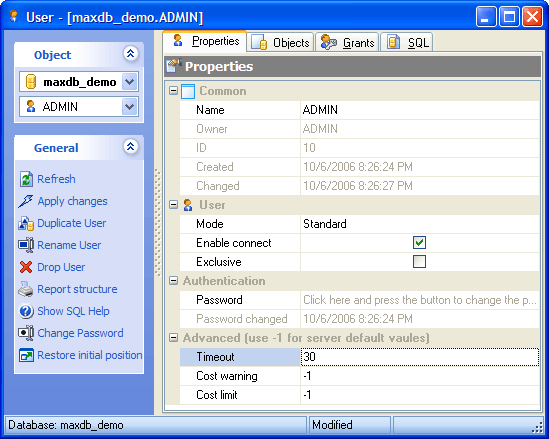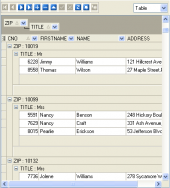MaxDB Maestro online Help
| Prev | Return to chapter overview | Next |
Editing user properties
User Editor provides you with an ability to edit user properties. The Properties tab allows you to change the user name, the user password, the user's ability to create databases and users, the role list the user belongs to.

Name
Use the field to edit user name.
Owner
Displays the user owner (The user owner is his creator).By default, only the owner of an object can perform various operations with the object. In order to allow other users to operate it, privileges must be granted. (However, users that have the superuser attribute can always access any object.)
ID
The field represents the database user ID. All database users has a unique ID. If you restart or restore the database instance, the database system uses the ID to check if the log entries and backups that are to be used really belong to this user.
Created
Indicates the date when the user was created.
Changed
Indicates the date when the user was last modified.
User Mode
The field allows you to change the user mode characterizing the user authorization.
STANDARD - Access to data and database procedures that were defined by other database users and for which the user has been given privileges. Definition of view tables, synonyms and temporary tables
RESOURCE - Definition of data and database procedures. Granting of privileges for these database objects to other database users
DBA (database administrator) - Creation of RESOURCE and STANDARD database users
Definition of database objects. Granting of all or part of privileges for these database objects to other database users
Enable connect
You use the option to define whether a user can open database sessions.
Exclusive
Check the option to prevent the user from opening several different database sessions simultaneously.
Password
Use the field to change the password for the user been creating.
Password changed
The field represents the date of the last password modification.
Timeout
The timeout value determines the maximum duration of inactivity in a database session. The duration of inactivity is the time interval between ending an SQL statement and sending the next SQL statement. As soon as the timeout value is exceeded, the database system ends the database session with a ROLLBACK. The value is specified in seconds and must be between 30 and 32400.
Cost warning
Use the field to edit the estimated SELECT cost value beyond which the user receives A warning. In this case, the user is asked whether he or she really wants to execute the SQL statement. The Cost limit value must be less than the Cost warning value.
Cost limit
Set here the estimated SELECT cost value beyond which the SQL statement is not executed.
The Cost limit value must be greater than the Cost warning value.
To apply the changes, select the Apply Changes item in the Navigation bar or use Ctrl+F9 or Ctrl+F7 shortcut keys.
It is also possible to modify object properties without opening the object editor: use the Object Properties item of the popup menu of the selected object from the explorer tree.
| Prev | Return to chapter overview | Next |




 Download
Download Buy
Buy

